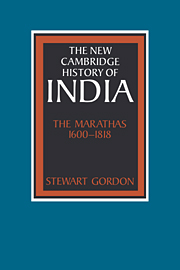Book contents
- Frontmatter
- Introduction: historiography and bibliography
- 1 The Geopolitics of Maharashtra
- 2 Marathas and the Deccan Sultanates
- 3 Shivaji (1630–80) and the Maratha polity
- 4 Responses to family invasion (1680–1719)
- 5 Baji Rao I's northern expansion (1720–1740)
- 6 Conquest to administration (1740–1760)
- 7 Centripetal forces (1760–1803)
- Index
- THE NEW CAMBRIDGE HISTORY OF INDIA
- References
4 - Responses to family invasion (1680–1719)
Published online by Cambridge University Press: 28 March 2008
- Frontmatter
- Introduction: historiography and bibliography
- 1 The Geopolitics of Maharashtra
- 2 Marathas and the Deccan Sultanates
- 3 Shivaji (1630–80) and the Maratha polity
- 4 Responses to family invasion (1680–1719)
- 5 Baji Rao I's northern expansion (1720–1740)
- 6 Conquest to administration (1740–1760)
- 7 Centripetal forces (1760–1803)
- Index
- THE NEW CAMBRIDGE HISTORY OF INDIA
- References
Summary
None of Shivaji's plans to divide the kingdom prevented the factionalization of the court, which began about the time of his final illness in 1678. One faction supported Sambhaji, the other a much younger son, Rajaram, then eight years old. This factionalization at the center, caused in part by Mughal military pressure, forms the main theme of this chapter. We will look at the shifting and delicate balance between power at the center and power held by the principal commanders; further, we will examine survival strategies and accommodations of various families and the long-term effects of warfare on Maharashtra. Finally, we will look at what government “control” and “conquest” meant in this period, and the problems the Mughals had in integrating Maratha families into the mansabdari system.
Immediately after Shivaji's death, a group of ministers and one of Shivaji's wives crowned Rajaram, who was promptly opposed by several of the most powerful Maratha families and Sambhaji. It took months for Sambhaji to crush the opposing faction, and it was more than eight months before his coronation took place (in December, 1680).
As successions go, this one was not crippling, and Sambhaji's first few years looked much like Shivaji's later strategies. There was, for example, a campaign against the Sidi's sea forts on the Konkan coast, which was not particularly successful. Also in a similar way to the late campaigns of Shivaji, Shambhaji sent a large army into the Karnatak in April 1681. The army was defeated by Chickadevaraja of Mysore; various campaigns there continued with the Marathas involved in the affairs of Mysore, Madura, and Golconda throughout the 1680s – sometimes as allies, sometimes as adversaries, sometimes as tribute collectors.
- Type
- Chapter
- Information
- The Marathas 1600–1818 , pp. 91 - 113Publisher: Cambridge University PressPrint publication year: 1993

